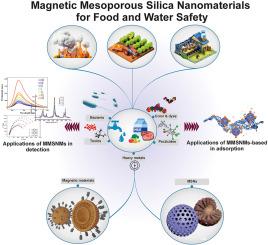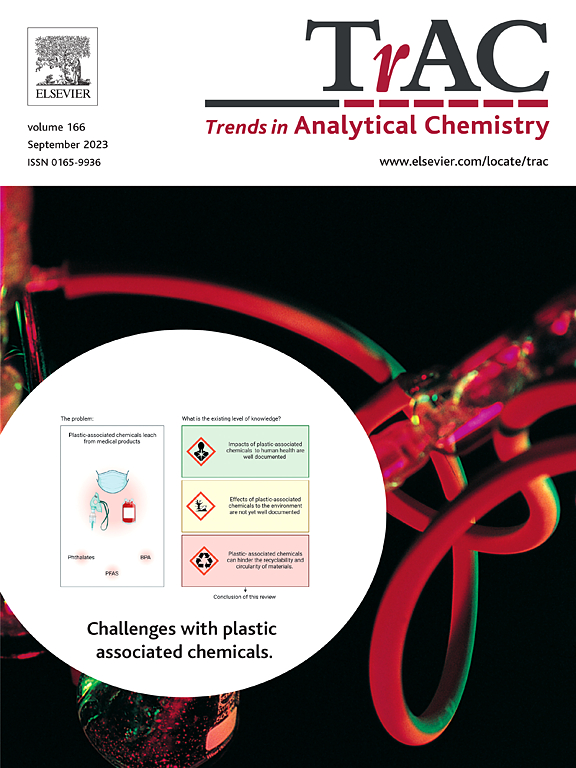Ensuring food and water safety using magnetic mesoporous silica nanomaterials-based biosensors
IF 11.8
1区 化学
Q1 CHEMISTRY, ANALYTICAL
引用次数: 0
Abstract
The recognition and removal of contaminants in food and water have attracted intensive research over the last two decades. Despite attempts by conventional analytical techniques, including physical, chemical, and biological methods, these approaches suffer from various limitations, such as requiring expert operators and complex sample preparation and clean-up. Recently, magnetic mesoporous silica nanomaterials (MMSNMs) have attracted great attention as a promising nanomaterial for the identification and removal of contaminants in food and water driven by two concepts. Firstly, the presence of magnetic nanomaterials in the structure of mesoporous silica nanomaterials can not only increase conductivity but also enhance the ability to capture various targets due to the functional groups on their surface, significantly improving the detection of water/food contaminants. Secondly, the magnetic separation characteristic of MMSNMs can be employed to remove contaminants in water. This review aims to present state-of-the-art advances and technological breakthroughs in MMSNMs fabrication such as sol-gel, ethanol reflux, and co-polymerization and their applications in food/water safety analysis. In addition, the development of MMSNM substrates for adsorption-based removal of water contaminants is explored. Finally, the working strategies, role of MMSNMs, advantages, and limitations of the research are discussed, followed by presenting the challenges and future trends.

利用基于磁性介孔二氧化硅纳米材料的生物传感器确保食品和水安全
在过去的二十年里,对食品和水中污染物的识别和清除引起了人们的深入研究。尽管传统的分析技术(包括物理、化学和生物方法)进行了尝试,但这些方法存在各种局限性,例如需要专业的操作人员以及复杂的样品制备和清理。最近,磁性介孔二氧化硅纳米材料(MMSNMs)作为一种很有前途的纳米材料,在食品和水中污染物的识别和去除方面引起了人们的极大关注。首先,磁性纳米材料在介孔二氧化硅纳米材料结构中的存在不仅能提高导电性,还能因其表面的功能基团而增强捕获各种目标的能力,从而显著提高水/食品污染物的检测能力。其次,MMSNMs 的磁分离特性可用于去除水中的污染物。本综述旨在介绍 MMSNMs 制备(如溶胶-凝胶法、乙醇回流法和共聚合法)的最新进展和技术突破及其在食品/水安全分析中的应用。此外,还探讨了基于吸附去除水污染物的 MMSNM 基质的开发。最后,讨论了研究的工作策略、MMSNM 的作用、优势和局限性,并提出了挑战和未来趋势。
本文章由计算机程序翻译,如有差异,请以英文原文为准。
求助全文
约1分钟内获得全文
求助全文
来源期刊

Trends in Analytical Chemistry
化学-分析化学
CiteScore
20.00
自引率
4.60%
发文量
257
审稿时长
3.4 months
期刊介绍:
TrAC publishes succinct and critical overviews of recent advancements in analytical chemistry, designed to assist analytical chemists and other users of analytical techniques. These reviews offer excellent, up-to-date, and timely coverage of various topics within analytical chemistry. Encompassing areas such as analytical instrumentation, biomedical analysis, biomolecular analysis, biosensors, chemical analysis, chemometrics, clinical chemistry, drug discovery, environmental analysis and monitoring, food analysis, forensic science, laboratory automation, materials science, metabolomics, pesticide-residue analysis, pharmaceutical analysis, proteomics, surface science, and water analysis and monitoring, these critical reviews provide comprehensive insights for practitioners in the field.
 求助内容:
求助内容: 应助结果提醒方式:
应助结果提醒方式:


